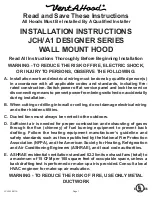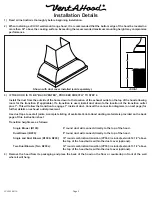
Page 5
JCH/A1 0611A
Installation Details Continued
8) If the duct cover is not factory-installed on the hood, remove the duct cover from its packaging and remove the mounting
screws from the base of the duct cover. Place the duct cover on the top of the hood and secure it to the hood using
the mounting screws previously removed. Lift the hood and duct cover assembly to the location on the wall where it
will be installed and lightly mark the wall with a short, horizontal mark along the bottom edge of the hood.
9) Remove the hood and duct cover assembly from the wall. On the back side of the hood, measure the distance between
the bottom edge of the hood and the top edge of the wood mounting strip. Measure this distance above the horizontal
line made in Step 8 and lightly mark the wall with a level, horizontal line. Measure where the center (left to right) of the
hood will be and mark the upper, horizontal line on the wall with a short, vertical centerline.
10) Remove the screws inside the top of the back of the hood that retain the wood strip that is recessed in the mounting
channel. Note: Some retaining screws may be located behind the blower(s). Remove the wood mounting strip from
the back of the hood and place the top edge of the strip on the upper, level horizontal line on the wall. Referencing the
vertical centerline from Step 9, place the mounting strip on the wall so it is centered (left to right) in the space where
the hood will be located. Drill pilot holes in the strip to prevent splitting. Using proper hardware, attach the mounting
strip to at least two wall studs.
7) Install an appropriate 1/2” UL listed electrical wire clamp through each motor box electrical opening on top of the hood.
Install electrical wiring from the service panel to the hood location for each motor box. Consult the connection diagrams
(on previous page) for further details on electrical placement. Extend wire(s) to the hood. Electrical connection(s) will
occur before the hood is installed on the wall.
Warning: Make sure power is off and locked at the service disconnecting
means on the service panel during installation.
Model
Volts
Amps*
Hz
RPM
CFM
[email protected]" Equivalent CFM
•
CFM
CFM
CFM
Minimum Round
Duct Size
Sones
#
B100 Single
115
1.5
60
1550
300
450
273
245
225
6" (28 in.
2
)
5.4
B200 Dual
115
2.9
60
1550
600
900
531
480
430
8" (50 in.
2
)
6.5
B200 Dual & B100 Single
115
4.4
60
1550
900
1350
804
725
655
10" (79 in.
2
)
6.3
Two B200 Duals
115
5.8
60
1550
1200
1800
1062
960
860
12" (113 in.
2
)
6.6
* Add 2.5 amps for each warming light and 0.5 amp for each halogen light.
• Because the Magic Lung
®
blower uses centrifugal filtration rather than conventional baffle or mesh filters, the Magic Lung
®
blower can handle cooking equipment with higher cubic feet per minute (CFM) requirements and can deliver equivalent CFM much more
efficiently than other than other filtration systems. When comparing the Magic Lung
®
with other blower units made by other manufacturers, use the “Equivalent CFM”.
#
Ratings in accordance with the Standard Test Code by the Energy Systems Laboratory of the Texas Engineering Experiment Station.
5) Remove the shipping tape that is securing the E-Z Clean shield(s) inside the hood. Remove the E-Z Clean shield(s) by
lightly pulling it toward the front of the hood. Gently close the back draft damper(s) from the top side of the hood. To
remove the blower housing(s), unsnap the suitcase latches (one on each side of the housing). The housing(s) should
be pulled forward and gently “tipped” to clear the blower wheel(s) and then out of the hood.
6) Remove the three screws retaining the blower motor(s). Unplug
and remove the motor(s), taking care not to damage the blower
wheel(s). It is not necessary to remove the blower wheel from
the motor.







